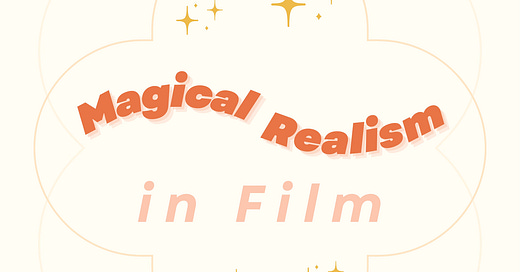Magical Realism in Film
Searching for inspiration and adventure? Explore magical realities across cinema.
There is magic in the world around us.
Don’t believe me? Just look at the works of Frida Kahlo, Laura Esquivel, Gabriel García Márquez, Toni Morrison, Haruki Murakami, and Neil Gaiman.
What do all these creatives have in common? Magical realism.
Popularized in Latin America, magical realism is “characterized by the matter-of-fact inclusion of fantastic or mythical elements into seemingly realistic fiction.”1 The lines between fantasy and reality are blurred.
Magical realism novels, television shows, and films typically follow a pattern:
Realistic setting - Unlike fantasy, there is no complex world-building. Readers or viewers don’t have to venture far to enter a familiar, contemporary place.
Magical elements - Mythical creatures or powers may exist. The revival of dead characters, telepathy, and time-traveling are common possibilities.
Limited information - Audiences witness the marvelous effects of magic, but its origins and lore are unknown.
Characters accept the magic - Instead of questioning the rules of their world, characters focus on goals, overcome obstacles, and persevere. They share the same emotional highs and lows as regular people. The only difference is the presence of mysterious or unseen forces.
Symbols and imagery - Immersive sensory details enrich the story’s atmosphere. In response to beguiling descriptions and startling visuals, audiences unknowingly suspend disbelief.
Unique plot structure - Not all narratives have a clear beginning, middle, and end. Some reinvent accepted techniques, subverting conventional laws of time and space.
Shift in points of view - In some cases, the narrator switches from one central character to another. Multiple voices enhance dimensionality. Each unique perspective challenges preconceived notions and unveils plot points from different angles.
Juxtaposition of past and present events - The narrator may guide audiences down memory lane. While most retellings are trustworthy, others can be unreliable. When juxtaposed with present events, readers or viewers gain a deeper understanding of the story and its themes. Finding and fitting together the puzzle pieces only makes the journey more enthralling!
Extended metaphors - Magical realism is a genre notable for critiquing social or political issues. Antagonists may be elite powers that take advantage of the less fortunate to achieve selfish goals. After observing the modern world, authors and filmmakers explore their pressing questions through art.
Cinema has elevated magical realism to new heights with mesmerizing sounds and visuals.
Let’s explore 10 incredible on-screen examples!
About Time (2013)
Amélie (2001)
Edward Scissorhands (1990)
Frida (2002)
Like Water for Chocolate (1992)
Magnolia (1999)
Pan's Labyrinth (2006)
The Curious Case of Benjamin Button (2008)
Trainspotting (1996)
Wings of Desire (1987)
I have seen and loved every film from the list above.
Why did they resonate?
Every motion picture provided a visceral experience. From beginning to end, I felt invested in the characters’ lives. I empathized with their plights and hoped for timely victories. No matter how fantastical the magic in the fictional worlds, I felt a strong connection. As the events unfolded, I began to believe in the impossible magic of my own reality.
The stories also answer some of life’s greatest questions. What is our purpose? Are our lives intertwined? How do you recover from tragedy? Do soulmates truly exist?
All humans are searching for answers. Art helps us explore and discover them.






